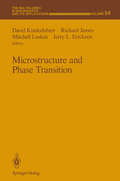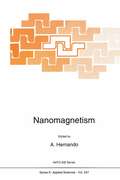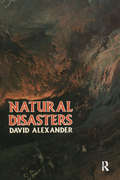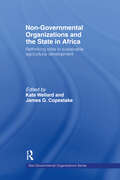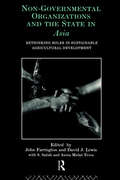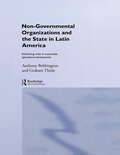- Table View
- List View
Microstructure and Phase Transition (The IMA Volumes in Mathematics and its Applications #54)
This IMA Volume in Mathematics and its Applications MICROSTRUCTURE AND PHASE TRANSITION is based on the proceedings of a workshop which was an integral part of the 1990-91 IMA program on "Phase Transitions and Free Boundaries." We thank R. Fosdick, M.E. Gurtin, W.-M. Ni and L.A. Peletier for organizing the year-long program and, especially, D. Kinderlehrer, R. James, M. Luskin and J. Ericksen for organizing the meeting and editing these proceedings. We also take this opportunity to thank those agencies whose financial support made the workshop possible: the Army Research Office, and the National Science Foun dation. A vner Friedman Willard Miller. Jr. PREFACE Much of our traditional knowledge of materials and processes is achievf'd by observa tion and analysis of small departures from equilibrium. Many materials, especially modern alloys, ceramics, and their composites, experience not only larger but more dramatic changes, such as the occurrence of phase transitions and t.he creation of defect structures, when viewed at the microscopic scale. How is this observed, how can it be interpreted, and how does it influence macroscopic behavior? These are the principle concerns of this volume, which constitutes the proceedings of an IMA workshop dedicated to these issues.
Migration and Fate of Pollutants in Soils and Subsoils (Nato ASI Subseries G: #32)
by Domenico Petruzzelli Friedrich G. HelfferichExperts in soil and environmental sciences as well as in the theory of wave propagation and numerical modeling methods provide a comprehensive account of different aspects of pollutant migration in soils, aquifers, and other geological formations. Emphasis is laid on the analysis of contributing phenomena and their interactions, modeling, and the practical use of such knowledge and models for guidance in disposal operations, preventive measures to minimize ecological damage, prediction of consequences of seepage, and design of remedial actions. Topics covered include the chemical behavior of soils, sorption and retardation, biochemistry of pollutants, ion exchange and kinetics of reactions in soils, measurement of adsorption and desorption, multiphase hydrodynamics, multicomponent wave theory and the coherence concept, nonlinear wave propagation in geological formations, multiphase convective transport, diffusion and fast reaction, modeling pollutant transport, numerical methods, dispersion of contaminants from landfills, risk analysis, water reuse, and radioactive soil contamination at Chernobyl.
Mineralogie: Eine Einführung in die spezielle Mineralogie, Petrologie und Lagerstättenkunde
by S. MatthesModeling of Defects and Fracture Mechanics (CISM International Centre for Mechanical Sciences #331)
by G. HerrmannAll materials contain numerous defects, such as microcracks, microvoids, inhomogeneities, dislocations, etc., which precede possible fracture. Thus mathematical modeling becomes necessary. This volume contains some introductory material, aspects of fracture mechanics, the theory of crystal defects, computational micromechanics, and the heterogenization methodology.
Modelling Oceanic Climate Interactions (Nato ASI Subseries I: #11)
by Jürgen Willebrand David L. T. AndersonThe ocean plays a central role in determining the climate of the earth. The oceanic circulation largely controls the temporal evolution of cli mate changes resulting from human activities such as the increase of greenhouse gases in the atmosphere, and also affects the magnitude and regional distribution of those changes. On interannual and longer time scales the ocean is, through its interaction with the atmosphere, a source of important natural climate variations which we are only now beginning to recognise but whose cause has yet to be properly determined. Chem ical and biological processes in the ocean are linked to climate change, particularly through interaction with the global carbon cycle. A quantitative understanding of the oceanic role in the climate system requires models which include many complex processes and interactions, and which are systematically verified with observations. This is the ob jective of global research programs such as TOGA, WOCE, and JGOFS. Coupled numerical models of the oceanic and atmospheric circulation constitute the basis of every climate simulation. Increasingly it is recog nized that in addition a biological/chemical component is necessary to capture the pathways of carbon and other trace gases. The development of such coupled models is a challenging task which needs scientists who must be cognizant of several other disciplines beyond their own specialty.
Modern Group Analysis: Proceedings of the International Workshop Acireale, Catania, Italy, October 27–31, 1992
by N. H. Ibragimov M. Torrisi A. ValentiOn the occasion of the 150th anniversary of Sophus Lie, an International Work shop "Modern Group Analysis: advanced analytical and computational methods in mathematical physics" has been organized in Acireale (Catania, Sicily, October 27 31, 1992). The Workshop was aimed to enlighten the present state ofthis rapidly expanding branch of applied mathematics. Main topics of the Conference were: • classical Lie groups applied for constructing invariant solutions and conservation laws; • conditional (partial) symmetries; • Backlund transformations; • approximate symmetries; • group analysis of finite-difference equations; • problems of group classification; • software packages in group analysis. The success of the Workshop was due to the participation of many experts in Group Analysis from different countries. This book consists of selected papers presented at the Workshop. We would like to thank the Scientific Committee for the generous support of recommending invited lectures and selecting the papers for this volume, as well as the members of the Organizing Committee for their help. The Workshop was made possible by the financial support of several sponsors that are listed below. It is also a pleasure to thank our colleague Enrico Gregorio for his invaluable help of this volume.
Morphology of the Rocky Members of the Solar System
by Elazar Uchupi Kenneth O. EmeryThese words are written on the SOOth anniversary of Columbus' discovery of the New World. Surely the deep-space exploration of other worlds in our Solar System over the past few decades is an event of similar magnitude. Man has traveled far enough to see Spaceship Earth suspended alone in black space. And he has voyaged even farther to marvel at the crescent Earth rising over the Moon's cratered terrain. Instrumented spacecraft have toured the entire Solar System even beyond the ninth planet Pluto. This work of science Morphology of the Rocky Members of the Solar System is an inquiry about our extended home. As with the Darwinian and Copernican paradigms, the nature of our planetary system, as the extended world around us, has great significance for those who ponder the human condition. The deep-space views of our Planet Ocean with its sweeping clouds, and moving oceans and creeping continents must rank as the greatest photograph ever taken. Viewing Spaceship Earth hanging in the vast void is an almost frightening experience. We are so alone! It is easy to understand why so many are attracted to a simpler account of origins, like the allegorical tale of creation written in heroic style (but eschewing math, maps, figures, tables, references, and evidence) in the first eleven chapters of Genesis. This treatise examines the morphology of the six rocky planets and their 27 satellites from a broad perspective.
Motion and Structure from Image Sequences (Springer Series in Information Sciences #29)
by Juyang Weng Thomas S. Huang Narendra AhujaMotion and Structure from Image Sequences is invaluable reading for researchers, graduate students, and practicing engineers dealing with computer vision. It presents a balanced treatment of the theoretical and practical issues, including very recent results - some of which are published here for the first time. The topics covered in detail are: - image matching and optical flow computation - structure from stereo - structure from motion - motion estimation - integration of multiple views - motion modeling and prediction Aspects such as uniqueness of the solution, degeneracy conditions, error analysis, stability, optimality, and robustness are also investigated. These details together with the fact that the algorithms are accessible without necessarily studying the rest of the material, make this book particularly attractive to practitioners.
Mountains and Minerals/Rivers and Rocks: A Geologist’s Notes from the Field
by M.D. PicardIn this collection of essays, M. Dane (`Duke') Picard takes the reader on journeys across deserts, mountains, canyons, and rivers from the American Southwest to Italy and France. His blend of vivid description and humor evokes the rugged days of field petroleum geology in the Great Plains and pastel Badlands of Utah and Wyoming in the 1950s and later days unlocking the geological secrets of sandstone in the Rockies. Along the way, he pokes gentle fun at the academic life in stories that will make anyone smile who's ever sat on a faculty committee or chaired a professional meeting. The final essays on his travels through Provence and Italy are rich with details of the beauty and the history - both human and geological - of the regions. M.D. Picard is the author of numerous professional articles and books, and has served as president of the National Association of Geology Teachers, the Society of Sedimentary Geology, and the Rocky Mountain section of the American Association of Petroleum Geologists. He is well known to the geological community for the essays and book reviews he has published over the last ten years in geoscience journals and magazines.
Nanomagnetism (NATO Science Series E: #247)
by A. HernandoThe NATO Advanced Research Workshop on "Nanomagnetic Devices" was held in Miraflores de la Sierra, Madrid, Spain, from 14 to 19 September 1992. This book contains 21 invited articles related to suggestive and relevant aspects of Magnetism. The NATO Advanced Research Workshop was Co-directed by R.C. O'Handley, B. Heinrich and A. Hernando. The organisers as well as the participants are gratefully acknowledged to the NATO Science Committee. I also wish to thank the publishers for their advice and help in organizing the book. xi DESIDERATA OF STORAGE DEVICES C.E. YEACK-SCRANTON IBM Corporation, E02/005 5600 Cottle Road San Jose, CA 95139 USA ABSTRACT. Typical requirements on cost, capacity, and performance of today's magnetic storage devices and industry trends in these attributes are given. Scaling components, devices, and materials is shown to be a key factor in further improvement, Challenges to continued scaling are reviewed, particularly as they relate to magnetic nano-structures, materials, and characterization techniques.
Natural Disasters
by David AlexanderAs a well balanced and fully illustrated introductory text, this book provides a comprehensive overview of the physical, technological and social components of natural disaster. The main disaster-producing agents are reviewed systematically in terms of geophysical processes and effects, monitoring, mitigation and warning. The relationship between disasters and society is examined with respect to a wide variety of themes, including damage assessment and prevention, hazard mapping, emergency preparedness, the provision of shelter and the nature of reconstruction. Medical emergencies and the epidemiology of disasters are described, and refugee management and aid to the Third World are discussed. A chapter is devoted to the sociology, psychology, economics and history of disasters.; In many parts of the world the toll of death, injury, damage and deprivation caused by natural disasters is becoming increasingly serious. Major earthquakes, volcanic eruptions, droughts, floods and other similar catastrophes are often followed by large relief operations characterized by substantial involvement of the international community. The years 1990-2000 have therefore been designated by the United Nations as the International Decade for Natural Disaster Reduction.; The book goes beyond mere description and elevates the field of natural catastrophes to a serious academic level. The author's insights and perspectives are also informed by his practical experience of being a disaster victim and survivor, and hence the unique perspective of a participant observer. Only by surmounting the boundaries between disciplines can natural catastrophe be understood and mitigation efforts made effective. Thus, this book is perhaps the first completely interdisciplinary, fully comprehensive survey of natural hazards and disasters. It has a clear theoretical basis and it recognizes the importance of six fundamental approaches to the field, which it blends carefully in the text in order to avoid the partiality of previous works. It covers the earth and social sciences, as well as engineering, architecture and development studies. This breadth is made possible by virtue of a strong emphasis on simple principles of the interaction of geophysical agents with human vulnerability and response.; All students of environmental sciences/studies and geography should find this book useful. It is an introductory text which treats this dramatic subject area as something demanding serious academic treatment and not just as an assemblage of horror stories.; This book is intended for undergraduate students in geography and environmental studies/sciences. The book should also appeal to any professional or researcher concerned with man- environment relations, whether in social science or natural science or engineering.
Natural Disasters
by David AlexanderAs a well balanced and fully illustrated introductory text, this book provides a comprehensive overview of the physical, technological and social components of natural disaster. The main disaster-producing agents are reviewed systematically in terms of geophysical processes and effects, monitoring, mitigation and warning. The relationship between disasters and society is examined with respect to a wide variety of themes, including damage assessment and prevention, hazard mapping, emergency preparedness, the provision of shelter and the nature of reconstruction. Medical emergencies and the epidemiology of disasters are described, and refugee management and aid to the Third World are discussed. A chapter is devoted to the sociology, psychology, economics and history of disasters.; In many parts of the world the toll of death, injury, damage and deprivation caused by natural disasters is becoming increasingly serious. Major earthquakes, volcanic eruptions, droughts, floods and other similar catastrophes are often followed by large relief operations characterized by substantial involvement of the international community. The years 1990-2000 have therefore been designated by the United Nations as the International Decade for Natural Disaster Reduction.; The book goes beyond mere description and elevates the field of natural catastrophes to a serious academic level. The author's insights and perspectives are also informed by his practical experience of being a disaster victim and survivor, and hence the unique perspective of a participant observer. Only by surmounting the boundaries between disciplines can natural catastrophe be understood and mitigation efforts made effective. Thus, this book is perhaps the first completely interdisciplinary, fully comprehensive survey of natural hazards and disasters. It has a clear theoretical basis and it recognizes the importance of six fundamental approaches to the field, which it blends carefully in the text in order to avoid the partiality of previous works. It covers the earth and social sciences, as well as engineering, architecture and development studies. This breadth is made possible by virtue of a strong emphasis on simple principles of the interaction of geophysical agents with human vulnerability and response.; All students of environmental sciences/studies and geography should find this book useful. It is an introductory text which treats this dramatic subject area as something demanding serious academic treatment and not just as an assemblage of horror stories.; This book is intended for undergraduate students in geography and environmental studies/sciences. The book should also appeal to any professional or researcher concerned with man- environment relations, whether in social science or natural science or engineering.
Natural Physical Sources of Underwater Sound: Sea Surface Sound (2)
by B. R. KermanTo place this book in perspective it is useful for the reader to be aware of the recent history of the topic of underwater sound generation at the ocean surface by natural mechanisms. A meeting in Lerici, Italy in 1987 was convened within the NATO Advanced Research Workshop series, to bring together underwater acousticians and ocean hydrodynamicists to examine various mechanisms which generate sound naturally at the ocean surface. A record of that meeting was published in the NATO scientific publication series in 1988 under the title 'Sea Surface Sound'. That meeting was successful in inspiring and co ordinating both participants and non-attending colleagues to examine some key issues which were raised during the course of presentations and discussions. The understanding among those present was that another meeting should be convened 3 years hence to report and review progress in the subject. Accordingly the second conference was convened in Cambridge in 1990, whose proceedings are presented here. This volume represents a very gratifying increase in only a 3 year interval in our understanding of a number of physical processes which generate sound at the peripheries of oceans. In fact it represents both the acceleration of singular effort as well as the development of interdisciplinary sophistication and co-operation. The enthusiasm, goodwill, and intense scientific curiosity which characterized the Lerici meeting carried through to Cambridge. The collegial atmosphere established by the participants was perfectly timed to foster another major advance in studies of ocean surface sound.
Near Field Optics (NATO Science Series E: #242)
by D. W. Pohl Daniel CourjonScanning near-field optical microscopy (SNOM, also known as NSOM) is a new local probe technique with a resolving power of 10--50 nm. Not being limited by diffraction, near-field optics (NFO) opens new perspectives for optical characterization and the understanding of optical phenomena, in particular in biology, microelectronics and materials science. SNOM, after first demonstrations in '83/'84, has undergone a rapid development in the past two to four years. The increased interest has been largely stimulated by the wealth of optical properties that can be investigated and the growing importance of characterization on the nanometer scale in general. Examples include the use of fluorescence, birefrigence and plasmon effects for applications in particular in biology, microelectronics and materials science, to name just a few. This volume emerged from the first international meeting devoted exclusively to NFO, and comprises a complete survey of the 1992 activities in the field, in particular the variety of instrumental techniques that are currently being explored, the demonstration of the imaging capabilities as well as theoretical interpretations - a highly nontrivial task. The comprehensive collection of papers devoted to these and related subjects make the book a valuable tool for anybody interested in near-field optics.
Neural Network Perception for Mobile Robot Guidance (The Springer International Series in Engineering and Computer Science #239)
by Dean A. PomerleauDean Pomerleau's trainable road tracker, ALVINN, is arguably the world's most famous neural net application. It currently holds the world's record for distance traveled by an autonomous robot without interruption: 21.2 miles along a highway, in traffic, at speedsofup to 55 miles per hour. Pomerleau's work has received worldwide attention, including articles in Business Week (March 2, 1992), Discover (July, 1992), and German and Japanese science magazines. It has been featured in two PBS series, "The Machine That Changed the World" and "By the Year 2000," and appeared in news segments on CNN, the Canadian news and entertainment program "Live It Up", and the Danish science program "Chaos". What makes ALVINN especially appealing is that it does not merely drive - it learns to drive, by watching a human driver for roughly five minutes. The training inputstothe neural networkare a video imageoftheroad ahead and thecurrentposition of the steering wheel. ALVINN has learned to drive on single lane, multi-lane, and unpaved roads. It rapidly adapts to other sensors: it learned to drive at night using laser reflectance imaging, and by using a laser rangefinder it learned to swerve to avoid obstacles and maintain a fixed distance from a row of parked cars. It has even learned to drive backwards.
Neural Networks in Robotics (The Springer International Series in Engineering and Computer Science #202)
by George Bekey Kenneth Y. GoldbergNeural Networks in Robotics is the first book to present an integrated view of both the application of artificial neural networks to robot control and the neuromuscular models from which robots were created. The behavior of biological systems provides both the inspiration and the challenge for robotics. The goal is to build robots which can emulate the ability of living organisms to integrate perceptual inputs smoothly with motor responses, even in the presence of novel stimuli and changes in the environment. The ability of living systems to learn and to adapt provides the standard against which robotic systems are judged. In order to emulate these abilities, a number of investigators have attempted to create robot controllers which are modelled on known processes in the brain and musculo-skeletal system. Several of these models are described in this book. On the other hand, connectionist (artificial neural network) formulations are attractive for the computation of inverse kinematics and dynamics of robots, because they can be trained for this purpose without explicit programming. Some of the computational advantages and problems of this approach are also presented. For any serious student of robotics, Neural Networks in Robotics provides an indispensable reference to the work of major researchers in the field. Similarly, since robotics is an outstanding application area for artificial neural networks, Neural Networks in Robotics is equally important to workers in connectionism and to students for sensormonitor control in living systems.
Neural Systems: Analysis and Modeling
by Frank EeckmanIn recent years there has been tremendous activity in computational neuroscience resulting from two parallel developments. On the one hand, our knowledge of real nervous systems has increased dramatically over the years; on the other, there is now enough computing power available to perform realistic simulations of actual neural circuits. This is leading to a revolution in quantitative neuroscience, which is attracting a growing number of scientists from non-biological disciplines. These scientists bring with them expertise in signal processing, information theory, and dynamical systems theory that has helped transform our ways of approaching neural systems. New developments in experimental techniques have enabled biologists to gather the data necessary to test these new theories. While we do not yet understand how the brain sees, hears or smells, we do have testable models of specific components of visual, auditory, and olfactory processing. Some of these models have been applied to help construct artificial vision and hearing systems. Similarly, our understanding of motor control has grown to the point where it has become a useful guide in the development of artificial robots. Many neuroscientists believe that we have only scratched the surface, and that a more complete understanding of biological information processing is likely to lead to technologies whose impact will propel another industrial revolution. Neural Systems: Analysis and Modeling contains the collected papers of the 1991 Conference on Analysis and Modeling of Neural Systems (AMNS), and the papers presented at the satellite symposium on compartmental modeling, held July 23-26, 1992, in San Francisco, California. The papers included, present an update of the most recent developments in quantitative analysis and modeling techniques for the study of neural systems.
New Directions of Oceanographic Research and Development
by Noriyuki Nasu and Susumu HonjoThe earth where we live is the only planet of our solar system that holds a mass of water we know as the ocean, covering 70.8% of the earth's surface with a mean depth of 3,800 m. When using the term ocean, we mean not only the water and what it contains, but also the bottom that supports the water mass above and the atmosphere on the sea surface. Modern oceanography thus deals with the water, the bottom of the ocean, and the air thereon. In addition, varied interactions take place between the ocean and the land so that such interface areas are also extended domains of oceanography. In ancient times our ancestors took an interest in nearshore seas, making them an object of constant study. Deep seas, on the other hand, largely remained an area beyond their reach. Modern academic research on deep seas is said to have been started by the first round-the-world voyage of Her Majesty's R/V Challenger I from 1872 to 1876. It has been only 120 years since the British ship leftPortsmouth on this voyage, so oceanography can thus be considered still a young science on its way to full maturity.
Non-Equilibrium Thermodynamics with Application to Solids: Dedicated to the Memory of Professor Theodor Lehmann (CISM International Centre for Mechanical Sciences #336)
by W. MuschikThis book puts emphasis on developing the basic ideas behind the different approaches to non-equilibrium thermodynamics and on applying them to solids. After a survey about different approaches an introduction to their common fundamentals is given in the first part. In the second part the mechanical behavior of special materials such as viscoelasticity, viscoplasticity, viscoelastoplasticity, and thermoplasticity are discussed. The third part is devoted to extended thermodynamics. The basic ideas, phenomenological as well as microscopical, are reviewed and applied to thermo- and viscoelastic materials. Electromagnetic solids showing dielectric relaxation, such as ceramics, showing electromagneto-mechanical hysteresis and superconductivity are treated in the fourth part. In the last part stability with regard to constitutive equations is investigated. Especially stability of quasi-static processes and of elastic-plastic systems are discussed.
Non-Governmental Organizations and the State in Africa: Rethinking Roles in Sustainable Agricultural Development
This presents twenty specially commissioned case studies of farmer participatory approaches to agricultural innovation initiated by NGOs in Africa. Beginning with a broad review of institutional activity at the grassroots, the authors set the case material within the context of NGO relations with the State and their contribution to democratisation and the consolidation of rural civil society. Specific questions are raised: how good/bad are NGOs at promoting technological innovation and addressing constraints to change in present agriculture?; how effective are NGOs at strengthening grassroots organizations? and how do/will donor pressures influence NGOs and their links to the State? This title is part of a series on Non-Governmental Organizations co-ordinated by the Overseas Development Institute. To complete this comprehensive review and critique there are two other regional case study volumes on Asia and Latin America and an overview volume, Reluctant Partners?
Non-Governmental Organizations and the State in Africa: Rethinking Roles in Sustainable Agricultural Development
by Kate Wellard James G. CopestakeThis presents twenty specially commissioned case studies of farmer participatory approaches to agricultural innovation initiated by NGOs in Africa. Beginning with a broad review of institutional activity at the grassroots, the authors set the case material within the context of NGO relations with the State and their contribution to democratisation and the consolidation of rural civil society. Specific questions are raised: how good/bad are NGOs at promoting technological innovation and addressing constraints to change in present agriculture?; how effective are NGOs at strengthening grassroots organizations? and how do/will donor pressures influence NGOs and their links to the State? This title is part of a series on Non-Governmental Organizations co-ordinated by the Overseas Development Institute. To complete this comprehensive review and critique there are two other regional case study volumes on Asia and Latin America and an overview volume, Reluctant Partners?
Non-Governmental Organizations and the State in Asia: Rethinking Roles in Sustainable Agricultural Development (Non-Governmental Organizations series)
by John Farrington David J. Lewis S. Satish Aurea Miclat-TevesFirst published in 1993. Routledge is an imprint of Taylor & Francis, an informa company.
Non-Governmental Organizations and the State in Asia: Rethinking Roles in Sustainable Agricultural Development (Non-Governmental Organizations series)
by John Farrington David J. LewisFirst published in 1993. Routledge is an imprint of Taylor & Francis, an informa company.
Non-Governmental Organizations and the State in Latin America: Rethinking Roles in Sustainable Agricultural Development
by Anthony Bebbington, Graham Thiele, Penelope Davies, Martin Prager, Hernando RiverosThis presents twenty specially commissioned case studies of farmer participatory approaches to agricultural innovation initiated by NGOs in Latin America. Beginning with a broad review of institutional activity at the grassroots, the authors set the case material within the context of NGO relations with the State and their contribution to democratisation and the consolidation of rural civil society. Specific questions are raised: how good/bad are NGOs at promoting technological innovation and addressing constraints to change in present agriculture?; how effective are NGOs at strengthening grassroots organizations? and how do/will donor pressures influence NGOs and their links to the State? This title is part of a series on Non-Governmental Organizations co-ordinated by the Overseas Development Institute. To complete this comprehensive review and critique there are two other regional case study volumes on Asia and Africa and an overview volume, Reluctant Partners?
Non-Governmental Organizations and the State in Latin America: Rethinking Roles in Sustainable Agricultural Development
This presents twenty specially commissioned case studies of farmer participatory approaches to agricultural innovation initiated by NGOs in Latin America. Beginning with a broad review of institutional activity at the grassroots, the authors set the case material within the context of NGO relations with the State and their contribution to democratisation and the consolidation of rural civil society. Specific questions are raised: how good/bad are NGOs at promoting technological innovation and addressing constraints to change in present agriculture?; how effective are NGOs at strengthening grassroots organizations? and how do/will donor pressures influence NGOs and their links to the State? This title is part of a series on Non-Governmental Organizations co-ordinated by the Overseas Development Institute. To complete this comprehensive review and critique there are two other regional case study volumes on Asia and Africa and an overview volume, Reluctant Partners?
